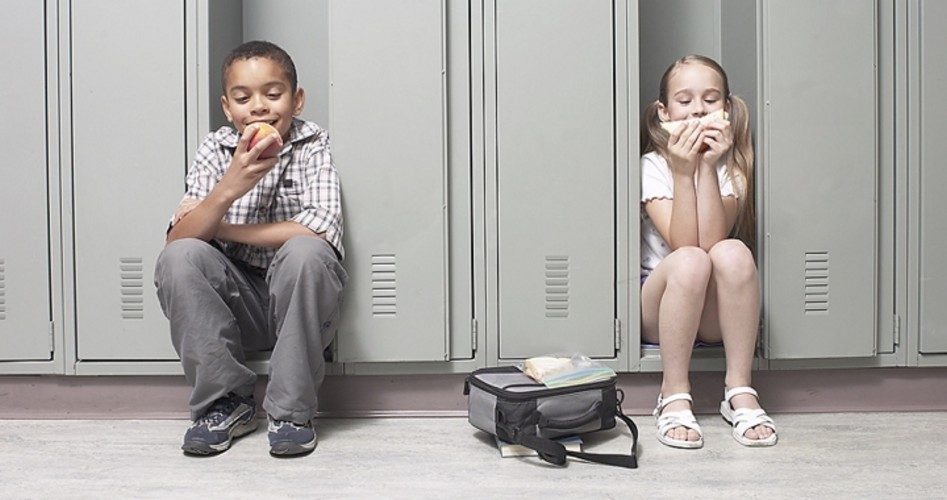
Unfortunately for public school districts across the country, First Lady Michelle Obama’s preferred lunch plan has proven to be a costly fiasco.
The new menus are defined by regulations stemming from the Healthy, Hunger-Free Kids Act of 2010. The new standards include a requirement that each student take a serving of fruit or vegetable as part of their lunch. If the standards are not met, the federal government may end its subsidies of the school lunch program — driving up prices for both students and school districts.
Under the standards, schools have had to forgo the cheaper enriched grains and instead serve more expensive whole grain choices such as brown rice, whole wheat breads, and whole grain pasta. Likewise, schools have been told to serve a wider variety of fruits and vegetables including red, yellow, and green leafy vegetables and low-sodium proteins.
The guidelines set minimum and maximum calories per meal by age group and provide sample lunch menus.
As predicted by some critics, however, the new regulations have met with growing opposition from students.
New York’s Burnt-Hills-Ballston Lake school district finally opted out of Michelle Obama’s menu plan after too many students complained that they were still hungry after eating the prepared lunches.
“[Food service manager Nicky] Boehm and her staff worked hard to implement the new regulations, but there were just too many problems and too many foods that students did not like and would not purchase,” said Assistant Superintendent Chris Abdoo about the National School Lunch Program in a statement reported by EAGNews.org. “Students complained of being hungry with these lunches and the district lost money.”
EAGNews noted that the federal menu included minute portions such as part of a chicken patty on a tiny croissant. Boehm said,
Students felt they weren’t getting good value for their money. The high schoolers especially complained the portion sizes were too small and many more students brought in lunch from home.
Instead, the school has opted to create its own lunch menu, after losing approximately $100,000 attempting the federal menu.
It is not the first school to drop out of the federal lunch program. Schools in Caitlin, Illinois, also withdrew from the program, asserting that it was too “restrictive.”
Similarly, schools in Carmel Clay, Indiana, have dropped Michelle Obama’s menu, asserting that they lost $300,000 attempting to implement the menu only to find that students were rejecting it.
“I’ve had a lot of complaints, especially with the little guys,” Linda Wireman, the food service director for Indiana’s Monon-based North White School Corp., told JCOnline. “They get a three-quarters cup of vegetables, but if it’s something they don’t like, it goes down the garbage disposal. So there are a lot of complaints they’re going home hungry.”
The new lunch regulations have officials feeling dismayed at some of the burdensome new responsibilities.
According to Amy Anderson, the food service director for the Carmel Clay schools in Indiana, the rules made her feel as though she were a “food cop.”
“I’m a registered dietician. I used to feel that I was an educator and part of the education system. I currently feel like I’m a food cop,” Anderson said. “I don’t get credit for the 98 percent of our kids who are within normal weight range. I only get slammed for the 2 to 3 percent who aren’t.”
And Lori Shofroth, Tippecanoe School Corps.’ food service director in Tippecanoe, Indiana, indicates that students have been throwing the food away.
“They’re teaching our kids with this meal pattern that it’s OK to throw away,” she told JCOnline. “We did a waste study on three different schools, and there was a huge amount of waste. That was just with produce, fruit or vegetables or milk.”
Ironically, wasted food was one of the very things First Lady Michelle Obama had hoped to avoid. Appearing at a Google Fireside Hangout last year, she declared, “I want every kid to commit to not throwing out anything.”
What’s worse is that some students are opting not to eat the lunch at all — defeating the purpose of the program, which is to ensure that students receive at least one solid meal a day. Not to mention that it is costing the school district a lot of money.
“I’ve got kids who can stop at Panera and pick up a sandwich that meets none of these criteria. I’m not maybe your typical school district, and they’re assuming that every student doesn’t have access to food, and that’s incorrect in this community,” Amy Anderson said. “Our kids can just wait and just hop in their BMWs and go to McDonald’s, which they’re rebuilding, making it bigger.”
Implementation of the program across the country has been difficult.
According to the Government Accountability Office, an unidentified school participated in a three-week boycott of the school lunch program when students grew angry at how drastically the bun on a sandwich had shrunk.
The GAO also reports that schools were substituting less nutritional items like ranch dressing and ice cream so as to meet the minimal amount of calories without surpassing the maximum amount of grains and meat.
An elementary school student in Florida’s Manatee County burst into tears upon learning that he would no longer be able to consume a peanut butter and jelly sandwich every day, an official told a congressional committee last month.
Congressman Todd Rokita (R-Ind.) opines that the regulations are too burdensome. “While well-intended, these new regulations have essentially put the federal government in the business of dictating the type, the amount, and even color of food that can and cannot be served in school cafeterias,” Rokita said. “Providing students healthier meals is a laudable goal we all share, but the stringent rules are creating serious headaches for schools and students.”
But some critics assert that the federal government should have no role in the dietary habits of the American people.
During an appearance at Wade’s Southern Cooking in Spartanburg, South Carolina, Fred Thompson summed up the issue of government intervention in American diets rather well. “I’m telling you, I don’t think that it’s the primary responsibility of the federal government to tell you what to eat,” the former U.S. senator from Tennessee said. “The fact of the matter is we got an awful lot of knowledge,” said Thompson. “Sometimes we don’t have a whole lot of will power, and I don’t know of any government program that’s going to instill that.”
And while the government has not yet decided it has the authority to take complete control our diets, at least not yet, it has engaged in these sorts of endeavors to “nudge” us in the right direction.
That notion seems to come straight from Cass Sunstein, the Obama administration’s regulatory czar who authored the book Nudge: Improving Decisions about Health, Wealth, and Happiness. Sunstein’s book provides a variety of measures that can be taken in order to “nudge” Americans towards healthier lifestyles while giving it the appearance that Americans are in fact making the decisions themselves, through the employment of behavioral psychology.
This is the driving premise behind Nanny State regulations such as the supersized soda ban in New York City, the removal of toys from Happy Meals in San Francisco — and of course the new federal lunch program.
But the American people continue to find ways to circumvent and reject the regulations. One wonders what government — whether at the city, state, or federal level, will attempt next.



